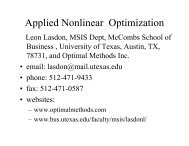[PDF] ALIO Back Matter
[PDF] ALIO Back Matter
[PDF] ALIO Back Matter
Create successful ePaper yourself
Turn your PDF publications into a flip-book with our unique Google optimized e-Paper software.
SD09<br />
■ SD09<br />
Aula 356- Third Floor<br />
Analytic Hierarchy Process<br />
Contributed Session<br />
Chair: Valerio Salomon, Professor, UNESP, Av, Ariberto Pereira da Cunha,<br />
333, Guaratinguetá, SP, 12516-410, Brazil, salomon@feg.unesp.br<br />
1 - Generic Framework to Structure Complex Social Systems<br />
Malcolm McKiggan, 1 Mary Street, Gawler East, 5118, Australia,<br />
mckiggan@bigpond.com.au<br />
Three Forms of Capital, defined as Individual, Collective and Institutional may be<br />
used as a framework for analysis of complex social systems at Strategic, Operational<br />
or Tactical levels and assist in the development of the Problem Definition by giving a<br />
relative social context to primary data. They support the construct of a suitable<br />
model for AHP or ANP prioritised trade off and sensitivity analysis highlighting<br />
fundamental knowledge, specific domain experience and social justice.<br />
2 - A Study on the Compatibility between Decision Vectors<br />
Claudio Garuti, Fulcrum Ingeniería Ltda., Luis Thayer Ojeda 0180,<br />
Oficina 1004, Santiago, Chile, claudiogaruti@fulcrum.cl,<br />
Valerio Salomon<br />
This work is related to the measurement of closeness or similarity among<br />
preferences. These preferences could come from a set of decision makers and their<br />
decision profiles or behavior patterns. The main difference among two types of<br />
measurement, cardinal and ordinal preferences, are included in this study. To deal<br />
with this subject, the compatibility index is presented in this work. Finally, some<br />
examples, on the compatibility indices utilization, are presented.<br />
3 - Two New Approaches to Set Priorities In Multicriteria Decision<br />
Problems Under Fuzzy Uncertainties<br />
Gustavo Schweickardt, Investigador, Instituto de Economía<br />
Energética - CONICET, Av. Bustillo km 9,500 - Centro Atómico,<br />
Bariloche, RN, 8400, Argentina, gschweickardt@arnet.com.ar,<br />
Gustavo Wiman<br />
In this work two approaches to set the priorities between criterias in multicriteria<br />
decisions problems, as an alternative for Eigen-Vector method, are presented. The<br />
uncertanties in the preferences are considered by mean fuzzy numbers, as an<br />
extension from the IAHP methodology. The approaches are based in Linear<br />
Programing (LP) and a new multiobjective Metaheuristics, named FEPSO. An<br />
example is presented and the adventages of LP and FEPSO respect the Eigen-Vector<br />
method, are evidenced.<br />
4 - Selection of the Proper Tool to Developing Indicators’ Panels for an<br />
Insurance Company: a Multicriteria Approach<br />
José Fabiano Serra Costa, Dsc., UERJ, Rua São Francisco Xavier 524,<br />
6028-B, Rio de Janeiro, RJ, 20559-900, Brazil, fabiano@ime.uerj.br,<br />
Karine Duarte<br />
Indicators’ panels consist in IT solutions to organize and present an up to date view<br />
of a company’s performance measures. These panels help in business maintenance<br />
and strategy, contributing significantly to decision making. Choosing the proper<br />
tools to build these panels is fundamental to obtain quality performance and easy<br />
user interface. This article presents the application of a multicriteria methodology to<br />
select the ideal tool to support an indicators’ panel for an insurance company.<br />
5 - Multiple Criteria Decision Making Modeling: An AHP Application to<br />
Production Layout<br />
Fernando Marins, Professor, UNESP, Av. Ariberto Pereira da Cunha,<br />
333, Guaratinguetá, SP, 12516-410, Brazil, fmarins@feg.unesp.br,<br />
Valerio Salomon, Ricardo Fino<br />
It was applied Analytic Hierarchy Process for the production layout’s arrangement. It<br />
was made a research in companies from the Paraiba River Valley, Brazil, and it was<br />
possible the elaboration of the criteria’s ranking considering the importance of each<br />
criterion in the industrial branches: Aeronautical, Automotive, Chemical,<br />
Metallurgical and Mechanic.<br />
<strong>ALIO</strong> / INFORMS International – 2010<br />
44<br />
■ SD10<br />
Aula 357- Third Floor<br />
Graph Spectra with Applications on<br />
Combinatorial Optimization II<br />
Cluster: Special Invited Sessions<br />
Invited Session<br />
Chair: Nair Abreu, Professor, Universidade Federal de Rio de Janeiro,<br />
Centro de Tecnologia, Bloco F, Sala 103 - Ilha do Fundão, Rio de Janeiro,<br />
22430-210, Brazil, nairabreunovoa@gmail.com<br />
1 - Eigenvector Centrality: A Better Way of Measuring<br />
Propagation of Technology<br />
Ana Isabel Azevedo Spinola Dias, Professor, Universidade Federal<br />
Fluminense(Depto de Ciíncia e Tecnologia), Rio das Ostras, RJ,<br />
Brazil, belspinola@gmail.com, Renata Del-Vecchio, Karla Gonçalves,<br />
Cynthia Bastos, Nair Abreu<br />
We constructed a graph to define which countries, with jointly applied patents, are<br />
the most central concerning propagation of technology. While degree centrality of<br />
the nodes measures the direct cooperation between countries, eigenvector centrality<br />
measures how much a country cooperates with countries that are cooperating with<br />
many other countries, and so on. Propagation of technology is better measured by<br />
eigenvector centrality.<br />
2 - Spectral Graph Theory Applied to the Graph Isomorphism Problem<br />
Philippe Leal Freire dos Santos, MSC Student - Departamento de<br />
Informática, Universidade Federal do Espírito Santo, Av. Fernando<br />
Ferrari, 514, Vitória, ES, 29075-910, Brazil, philippeleal@gmail.com,<br />
Maria Cristina Rangel, Maria Claudia Silva Boeres<br />
Spectral graph theory is the study of graph properties by their relationship with<br />
some specific linear algebra concepts. The concepts of graph spectrum and<br />
eigenvector centrality have been used in graph theory to characterize graph<br />
properties and extract relevant graph structural information. In this work an exact<br />
algorithm to detect the isomorphism between two graphs using their spectrum<br />
information and their eigenvector centrality is proposed.<br />
3 - Graphs with (k,t)-regulars Sets Corresponding to<br />
All Distinct Eigenvalues<br />
Paula Rama, PhD, Universidade de Aveiro, Campus Universitário de<br />
Santiago, Aveiro, Portugal, prama@ua.pt, Paula Carvalho<br />
Given a graph G=(V,E), a subset S of V is a (k,t)-regular set if S induces a k-regular<br />
subgraph and each vertex v not in S has t neighbors in S. We introduce a lower<br />
bound on the multiplicity of an eigenvalue of G associated with (k,t)-regular sets.<br />
We present some classes of graphs with (k,t)-regular sets corresponding to all<br />
distinct eigenvalues and we show some graph operations that generate graphs with<br />
(k,t)-regular sets for all distinct eigenvalues from graphs with the same property.<br />
4 - Some Regularity Properties of Circulant Graphs<br />
Paula Carvalho, Professor, Universidade de Aveiro, Campus<br />
Universitário de Santiago, Aveiro, Portugal, paula.carvalho@ua.pt,<br />
Paula Rama<br />
For a graph G=(V,E), a subset S of V is a (k,t)-regular set if S induces a k-regular<br />
subgraph in G and every v in V \ S has t neighbors in S. We characterize (k,t)regular<br />
sets for circulant graphs with symbol that fulfills some conditions and we<br />
prove its existence for certain values on the order of G. If G is regular, S is a (k,t)regular<br />
set if and only if k-t is an eigenvalue of G. Since circulant graphs are regular<br />
graphs, we obtain a combinatorial characterization of its spectrum.<br />
5 - A Survey of Orderings of Graphs by Algebraic Connectivity<br />
Claudia Justel, Professor, Instituto Militar de Engenharia, Praca<br />
General Tiburcio 80, Praia, Vermelha, Rio de Janeiro, 22290-270,<br />
Brazil, cmjustel@gmail.com, Nair Abreu, Oscar Rojo<br />
In this talk we present a survey of results about orderings of graphs by algebraic<br />
connectivity. A total ordering of trees by algebraic connectivity is not known. Some<br />
partial results about orderings of classes of trees of order n and fixed diameter d are<br />
well known: for diameter equal to 3 and 4 and diameter d for trees that are<br />
obtained from a path on d-1 vertices and two stars. Recently, other results have<br />
been obtained for subclasses of trees.


![[PDF] ALIO Back Matter](https://img.yumpu.com/17932960/24/500x640/pdf-alio-back-matter.jpg)
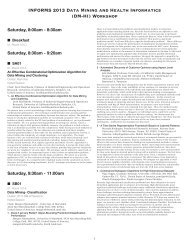
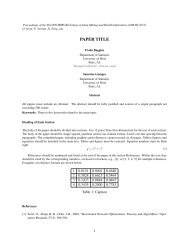
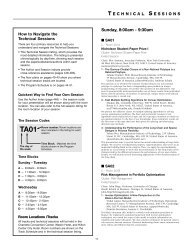
![[PDF] Charlotte Back Matter](https://img.yumpu.com/17933057/1/190x245/pdf-charlotte-back-matter.jpg?quality=85)

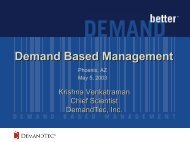
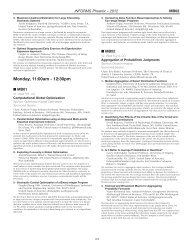
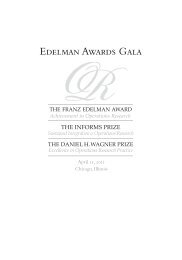
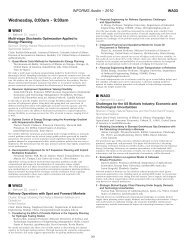
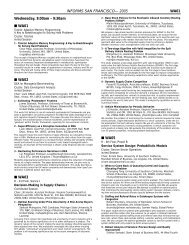
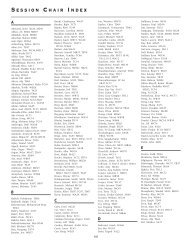
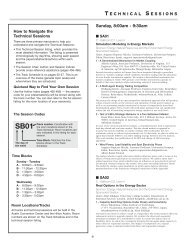
![[PDF] Monday, 8:00am - 9:30am](https://img.yumpu.com/17932954/1/190x245/pdf-monday-800am-930am.jpg?quality=85)
